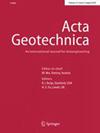Effect of multidirectional cyclic loading history on reliquefaction behaviors of sand: a microscale investigation
Abstract
Soil elements in situ are subjected to multidirectional shearing during earthquakes. Ignoring the effect of two horizontal shear components generally results in an underestimation of the liquefaction resistance of soils during earthquakes. The actual earthquake sequence generally consists of a mainshock and subsequent aftershocks. Soils may experience liquefaction during the mainshock and then reliquefy again during the subsequent aftershocks. Previous studies on multidirectional loading paths have mainly focused on single liquefaction events. This study employs 3D discrete element modeling to simulate reliquefaction behavior of sands with various multidirectional cyclic simple shear loading histories. The specimens are initially subjected to various strain histories under multidirectional loading paths and then reconsolidated to initial stress states. Subsequently, each soil specimen is subjected to unidirectional cyclic loading in two different directions in the reliquefaction tests. The influence of multidirectional cyclic loading histories on the post-liquefaction drainage compression and reliquefaction resistance are analyzed. Moreover, the evolution of soil fabrics and interaction between fabric orientation and loading direction in the reliquefaction test are investigated. The results highlight that reliquefaction behavior of soils depends on both the fabric and the interaction between the fabric orientation and the loading direction. This study aims to provide micromechanical insight for understanding the effects of multidirectional shearing histories on reliquefaction resistance of sands.

 求助内容:
求助内容: 应助结果提醒方式:
应助结果提醒方式:


